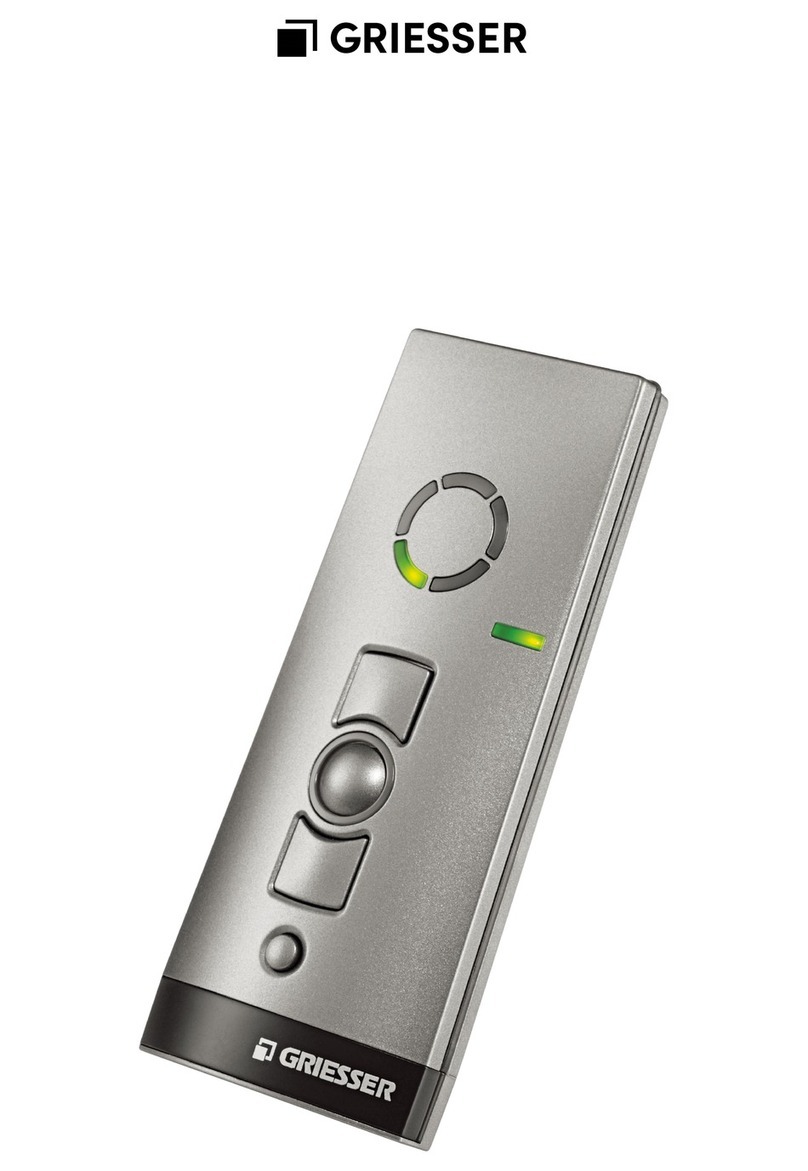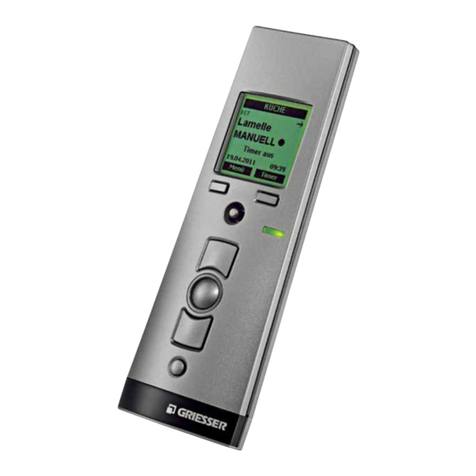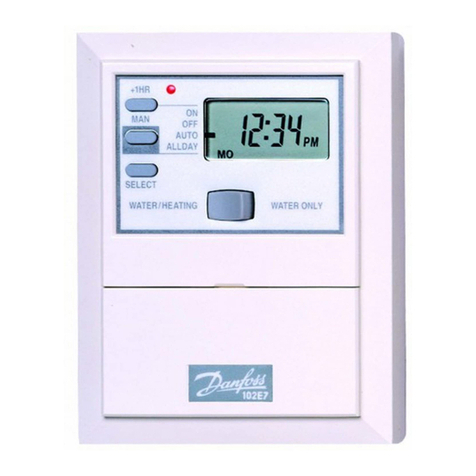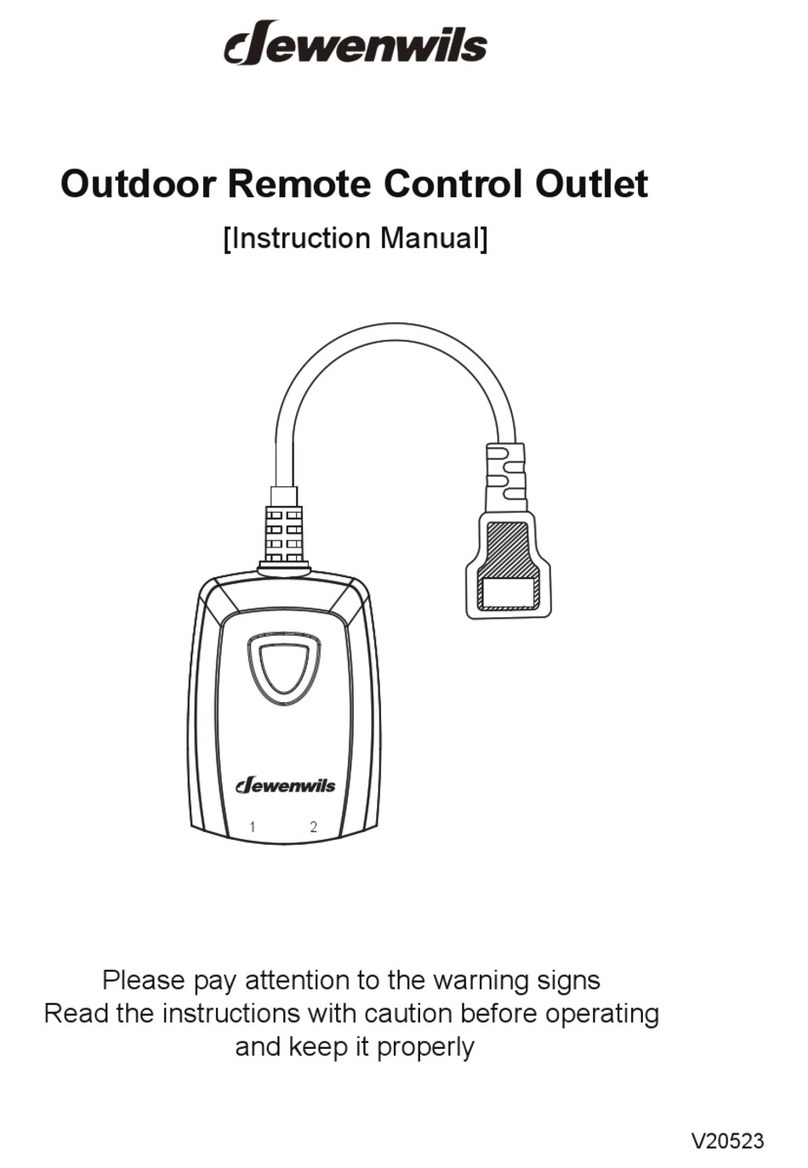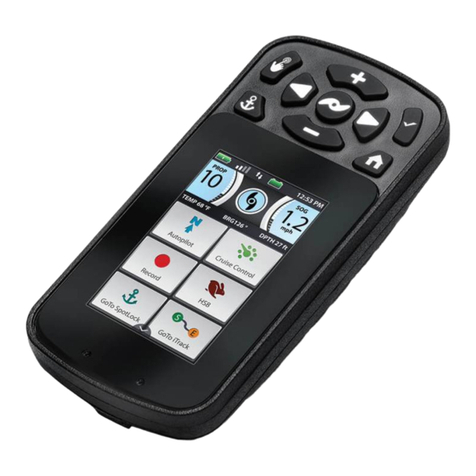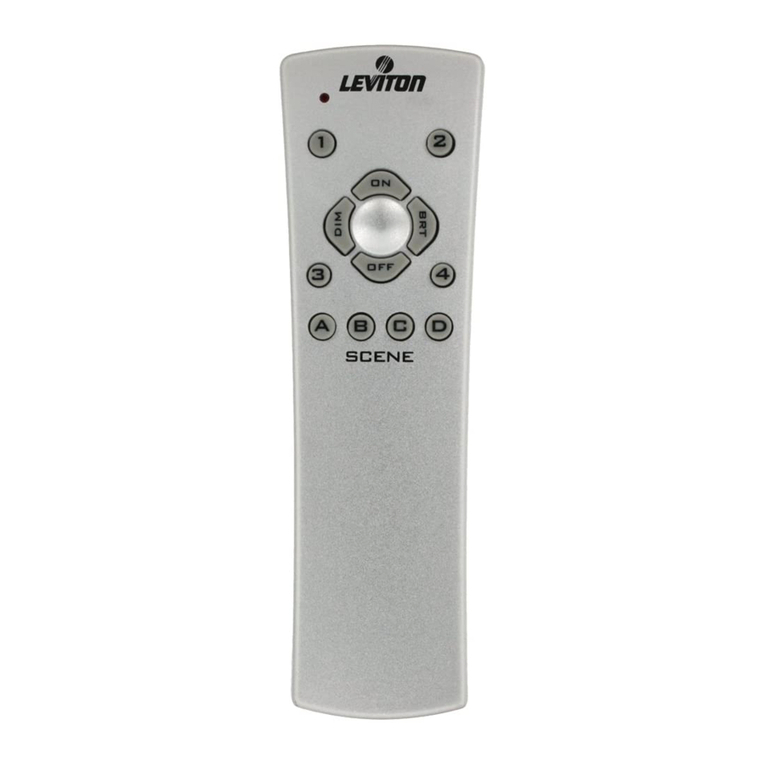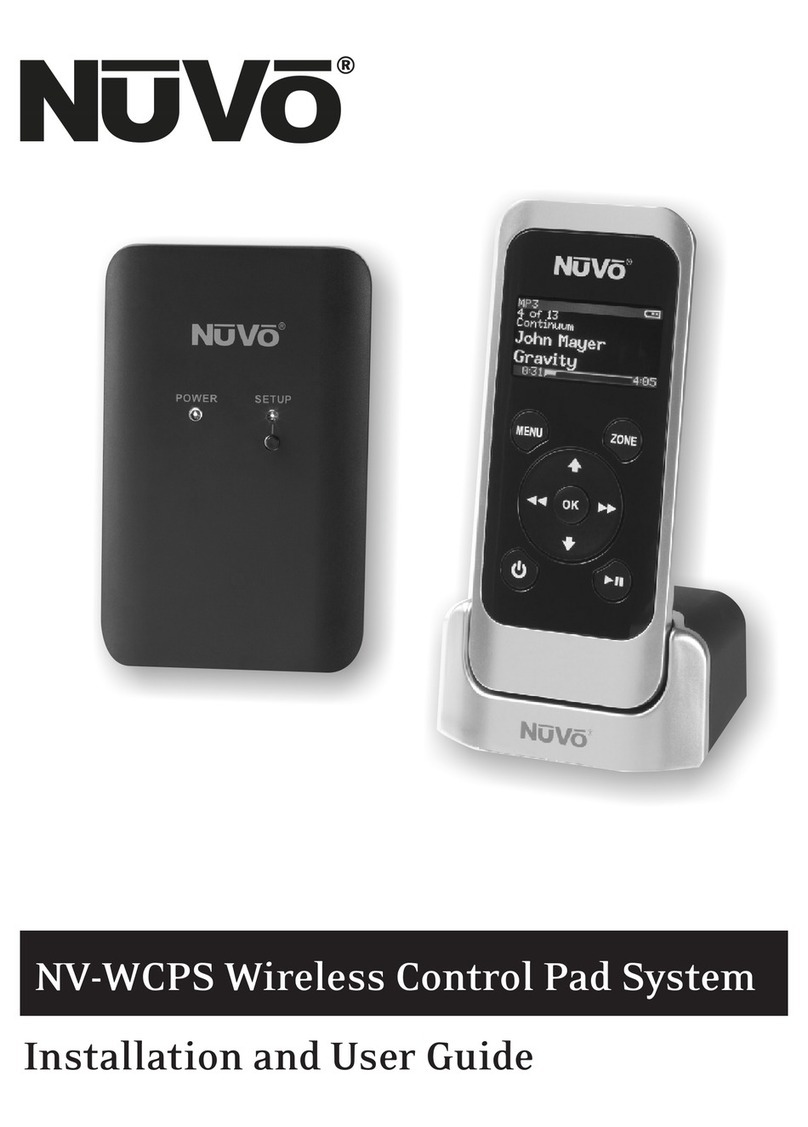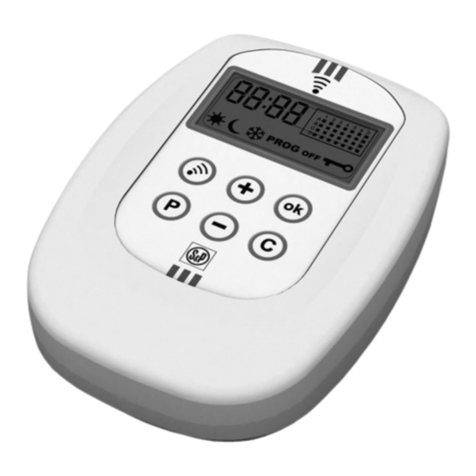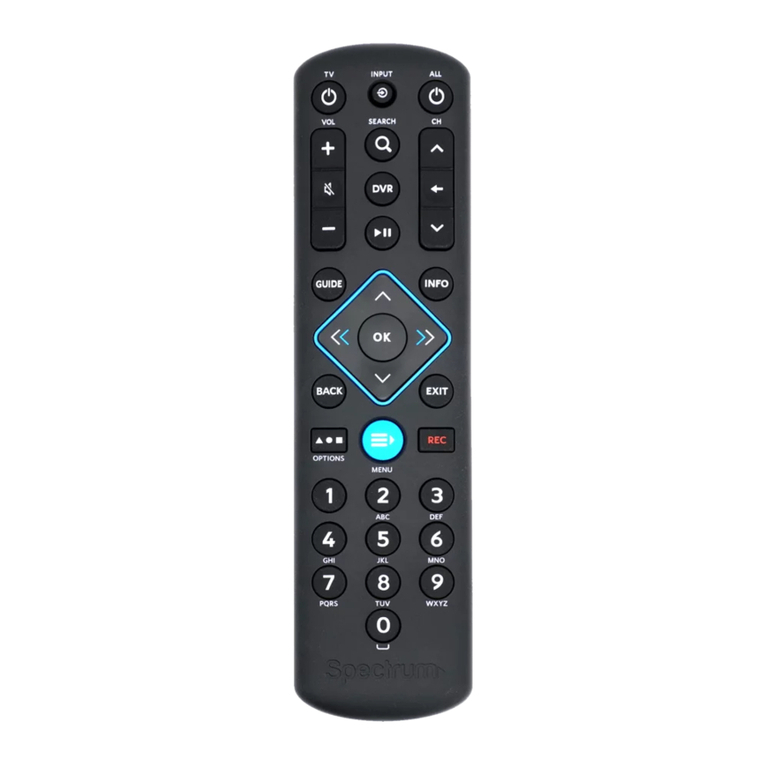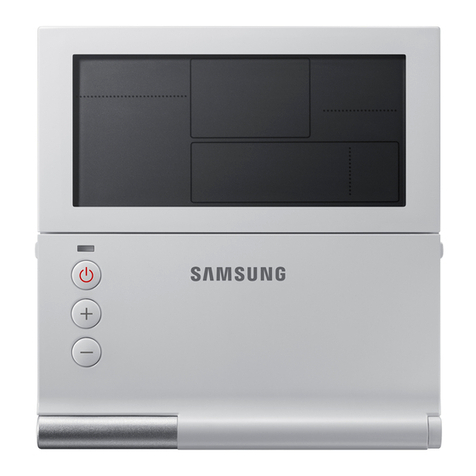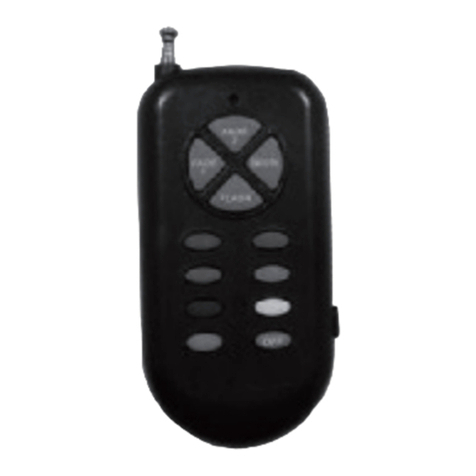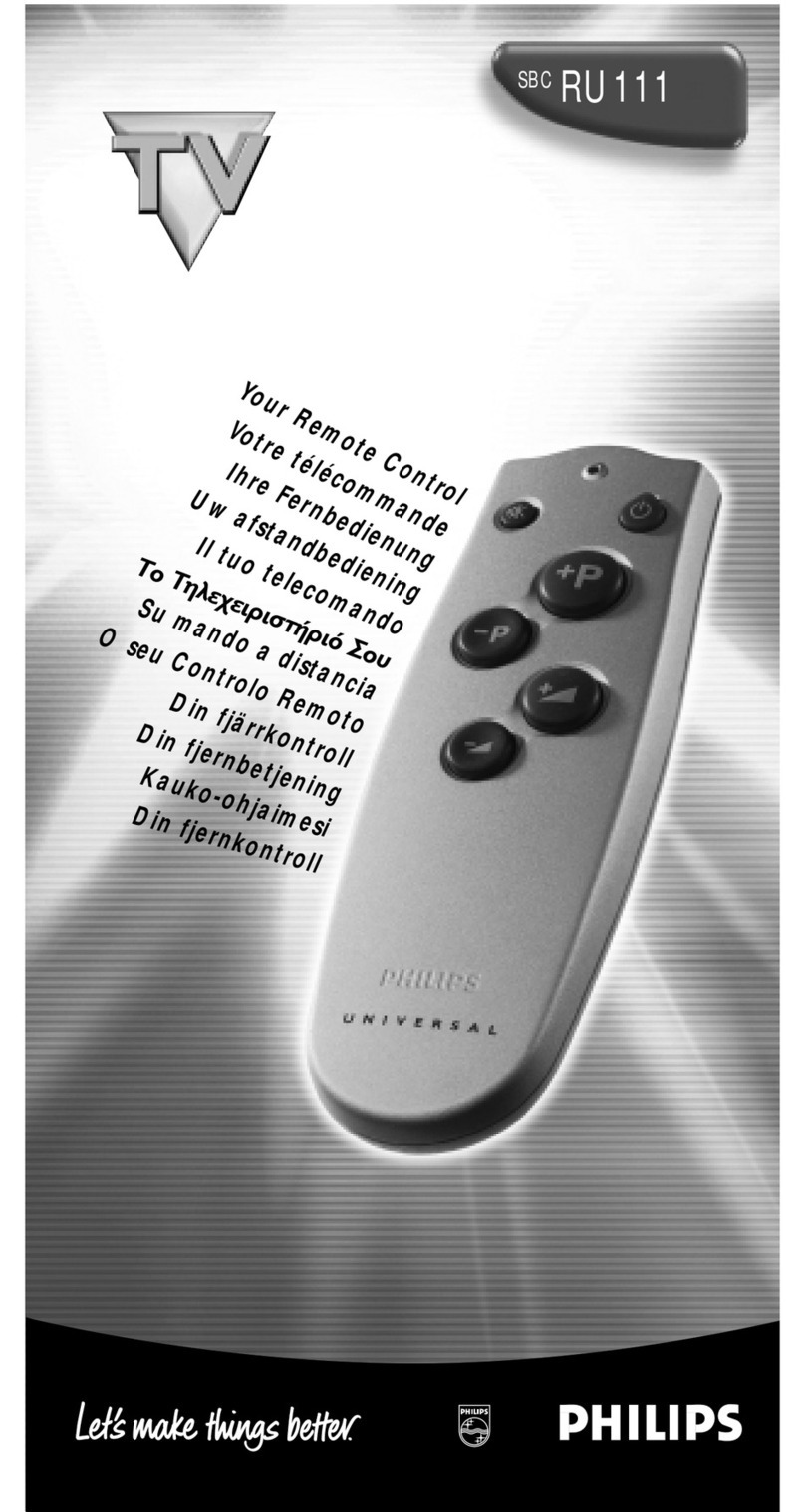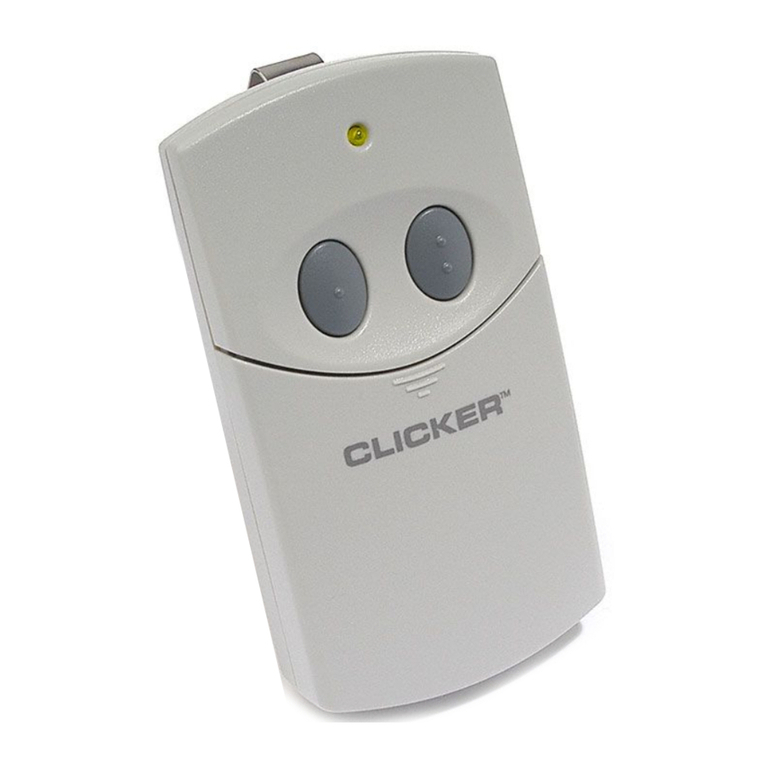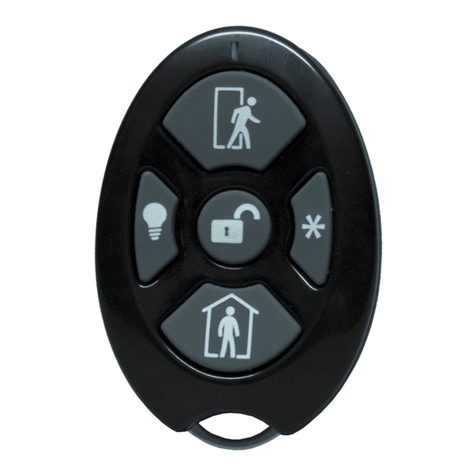Griesser SoloTel 2 User manual


© elero GmbH2 | EN © elero GmbH EN | 3
Safety instructions
The instructions must be observed in order to
ensure the product can be operated smoothly and
safely and its properties can be fully realised.
• The operator/user must have completely read and understood
the instructions.
• The operator must ensure that the instructions are available to
the user in a legible form.
• The operator must ensure that all safety measures are observed
and complied with.
• The following safety and assembly instructions apply to the
device and not to the accessories and drive.
CAUTION!
Failure to observe these can cause physical
injury!
Observe all safety instructions.
• Never install or take into operation devices which are damaged.
• Only use unmodified and compatible original parts.
• If the device is opened without permission or used in an improper
manner, or if it is incorrectly installed or operated, there is a risk
of injury to persons and damage to property.
• The device contains small parts which can be swallowed.
Transport
• Should you receive the device in a damaged condition despite
proper packaging, you must not put it into operation. Complain
about any damage to the transport company immediately.
Installation
• Observe the regulations during installation.
Contents
Safety instructions . . . . . . . . . . . . . . . . . . . . . . . . . . . 3
Safety instructions for radio operation . . . . . . . . . . . 4
Intended use . . . . . . . . . . . . . . . . . . . . . . . . . . . . . . . . 4
Exclusion of liability . . . . . . . . . . . . . . . . . . . . . . . . . . 5
Scope of supply. . . . . . . . . . . . . . . . . . . . . . . . . . . . . . 5
Technical Data . . . . . . . . . . . . . . . . . . . . . . . . . . . . . . . 5
Mounting of wall bracket . . . . . . . . . . . . . . . . . . . . . . 6
Device explanation . . . . . . . . . . . . . . . . . . . . . . . . . . . 6
Explanation of functions. . . . . . . . . . . . . . . . . . . . . . . 7
Bidirectional radio system . . . . . . . . . . . . . . . . . . . . . 7
Unidirectional radio system. . . . . . . . . . . . . . . . . . . . 7
Initial operation . . . . . . . . . . . . . . . . . . . . . . . . . . . . . 7
Programming the transmitter . . . . . . . . . . . . . . . . . . 9
Programming additional transmitters . . . . . . . . . . . 10
Synchronous Programming Mode . . . . . . . . . . . . . 11
Stopping programming mode (bidirectional) in the
transmitter . . . . . . . . . . . . . . . . . . . . . . . . . . . . . . . . 12
Approaching end positions of roller shutter /
awning / Venetian blind. . . . . . . . . . . . . . . . . . . . . . 12
Operation of the transmitter using Combio JA Pulse14
Deleting positions/deleting transmitters . . . . . . . . . 15
Battery Replacement. . . . . . . . . . . . . . . . . . . . . . . . . 16
Cleaning . . . . . . . . . . . . . . . . . . . . . . . . . . . . . . . . . . . 16
Disposal . . . . . . . . . . . . . . . . . . . . . . . . . . . . . . . . . . . 16
Troubleshooting . . . . . . . . . . . . . . . . . . . . . . . . . . . . 16
Repair . . . . . . . . . . . . . . . . . . . . . . . . . . . . . . . . . . . . . 17
EC Declaration of conformity. . . . . . . . . . . . . . . . . . 18
Address . . . . . . . . . . . . . . . . . . . . . . . . . . . . . . . . . . . 19
Safet
y
instructions

© elero GmbH4 | EN © elero GmbH EN | 5
which are fitted with elero-radio receivers. Other use, or use beyond
this is not considered to be use for intended purpose.
The handheld transmitter is referred to as "device" in this manual.
Exclusion of liability
elero GmbH assumes no liability for personal injuries, property
damage and financial losses which arise from use other than
mentioned above, modifications to the device, improper use and
failure to observe the operating instructions. Liability for material
defects is excluded in such cases.
Scope of supply
SoloTel 2 (battery included in the device), wall bracket, 2 wall plugs,
2 screws.
Technical Data
Name of device SoloTel 2
Operating voltage 3 V DC
Battery type 1 x CR 2032
IP Code IP 20
Temperature range 0 to +55 °C
Radio frequency 868 MHz frequency band
Dimensions in mm (wall bracket) L 85 x W 85 x H 18
Weight in grams (including.
batteries).
45
There are different device names for the USA, Canada, Australia
and some countries in South America.
Radio frequency 915 MHz frequency band
Operation
• Use only in dry rooms.
• If one or more transmitters are used for controlling the system, its
operating range must stay visible during operation.
• Keep control systems out of the reach of children and the
disabled.
• Dispose of used batteries properly.
Safety instructions for radio operation
Observe all safety instructions for radio operation.
Only use radio systems which are approved and can be operated
without interference.
• Radio systems must not be operated in areas where there is an
increased risk of interference (e.g. hospitals, airports).
• The remote control is only approved for devices and systems for
which any malfunction of the transmitter or receiver would not
result in a risk for persons, animals or property, or if such a risk is
covered by other safety equipment.
• The operator has no protection whatsoever against interference
by other telecommunication installations and local terminals (e.g.
also from radio installations which are operated properly in the
same frequency range).
• The range of the radio signal is limited by legislation and the
structural conditions.
Intended use
The SoloTel 2 is a single-channel transmitter. It can be used
unidirectionally (compatible with the existing ProLine program) or
bidirectionally. The handheld transmitter should only be used for
controlling roller shutter, Venetian blinds and sun protection systems
Safet
y
instructions for radio operation
E
xclusion of liabilit
y

© elero GmbH6 | EN © elero GmbH EN | 7
On the back of the device
5
6
5 Learn button P
Explanation of functions
Bidirectional radio system
A bidirectional radio system transmits radio signals to a radio
receiver and enables feedback from the radio receiver to the
transmitter. The radio signal can be sent directly to the target
receiver. If this is not possible then the radio signal is forwarded via
other bidirectional participants until the signal reaches the target
receiver. The target receiver carries out the command and sends a
confirmation back to the transmitter.
Bidirectional radio operation is only possible if all participants are
bidirectional. Otherwise, the system is only unidirectional.
Unidirectional radio system
A unidirectional radio system transmits radio signals to radio
receivers. However,in contrast to the bidirectional radio system,
the radio receivers cannot send back a reply to the transmitter. The
transmission of radio signals from radio receiver to radio receiver is
also not possible.
Initial operation
Press a button to switch on the handheld transmitter; the status
display is illuminated.
Mounting of wall bracket
• The wall bracket must be fixed so
that the drill holes do not touch
any electrical cables.
• Before installing the unit in the
required position, check that
the transmitter and receiver are
functioning perfectly.
• Attach the bracket to the wall
with the wall plugs and screws
provided.
Device explanation
Front of device
1
2
3
4
Status indicator
2 UP button
3 STOP button
4 DOWN button
85
85
7,5
7,5
M
ountin
g
of wall bracke
t
E
x
p
lanation of functions

© elero GmbH8 | EN © elero GmbH EN | 9
Group control unit
A group is understood to mean the control of several receivers
at the same time. The selected group is controlled by a travel
command.
Any number of receivers can be programmed and controlled in the
channel.
Programming the transmitter
Requirement
The receiver is installed. Check whether the channel is deleted or
in the correct mode according to the status display.
Stand in front of the blind to be programmed for the programming.
1. With electrical receivers which have already been installed,
switch the fuse off, and on again a few seconds later.
The receiver is now in programming mode for about 5 minutes.
2. Press the programming button Pon the back of the device briefly
(approx. 1 second) until the status display lights for a short time.
The blind moves up and down for approx. two minutes, showing
that the receiver is in programming mode.
3. Press the OPEN button as soon as the blind starts moving in
Open direction (within 1 second at the most). The status display
lights briefly.
The blind stops briefly, starts moving again, stops and then
moves in the Down direction.
4. Immediately (within maximum 1 second) after starting down
travel, press the DOWN button. The status display lights briefly.
The blind stops. The transmitter channel is programmed.
Note
If the blind does not stop, it must be programmed again.
A bidirectional programming process in the handheld
transmitter can be cancelled by pressing the STOP button for
6 seconds.
Note
Do not press the P button until the receivers are in
programming mode. The channel for a radio system is
decided during the programming. If the receivers are not in
programming mode, the channel of the sender changes to the
unidirectional mode. In order to restore the starting condition,
press the STOP and P- buttons simultaneously for 6 seconds
until the status display lights.
Status display
A radio signal is indicated by the illumination of the status display
(LED above the buttons). The different colours of the status display
mean:
Status display Meaning
Flashing orange Channel (transmitter) not programmed in any
receiver
Quick flashing
orange
Channel (transmitter) in bidirectional program-
ming mode. Operation of already programmed
receivers not possible.
Every 3 seconds in group programming mode
(also without pressing a button)
Orange Channel (transmitter) is operating bidirection-
ally: Transmit signal is being sent
Green Channel (transmitter) is operating unidirection-
ally: Transmit signal is being sent
Orange or green
flashes several times
then red
Channel (transmitter) is deleted
Flashing red Batteries weak
The transmitting power or the radio range will be reduced by
the reduction in the performance of the battery. If the voltage
drops below 2 V, functions are no longer executed and nothing is
displayed.
E
x
p
lanation of functions
E
x
p
lanation of functions

© elero GmbH10 | EN © elero GmbH EN | 11
If more than 10 bidirectional receivers are being programmed in the
channel at the same time, the transmitter channel in programming
mode switches to group mode. The group mode is indicated by fast
flashing with pauses.
Programming in group mode is completed after a 2-minute pause or
pressing the STOP button for 6 seconds.
Note
A jogging mode for Venetian blinds for quickly reaching
receivers which are further away is not possible in a transmitter
channel with more than 10 programmed receivers.
Synchronous Programming Mode
For programming additional receivers to one transmitter at the same
time:
1. Press the DOWN buttons and the programming button P(back
of device) simultaneously (for 3 seconds) on a transmitter which
has already been programmed to the receivers). The status
display flashes. The receivers are now in programming mode.
2. For bidirectional operation only: press the programming button
Pon the transmitter to be programmed until the status display
lights briefly. The receivers are now in programming mode (up/
down movements).
3. Press the OPEN button as soon as the blind starts moving in
Open direction (within 1 second at the most). The status display
lights briefly. The blinds stop briefly, start moving again, stop and
then move downwards.
4. Immediately (within maximum 1 second) after starting down
travel, press the DOWN button. The status display lights briefly.
The blinds stop moving. The transmitter channel is programmed.
Programming additional transmitters
Note
If several receivers are connected to the same feed line,
then all are simultaneously in programming mode for approx.
5 minutes after switching on the mains power.
If the Pbutton on the transmitter is now pressed, all the
receivers start programming mode at the same time (up/down
movements). Randomly different intervals between open /
down movements cause the receivers to become offset against
one another. The longer programming is delayed, the greater
the offset will be.
The short up/down movements can be stopped by pressing
the STOP button briefly on a transmitter which has already
been programmed. The programming mode in the receiver is
interrupted.
The transmitter can now be assigned without having to
disconnect individual receivers. If the blind moves in the wrong
direction, delete the transmitter and program it again.
(→see Deletion of transmitter)
For programming additional transmitters to one receiver:
1. Press the UP, DOWN buttons and the programming button P
(back of device) simultaneously (for 3 seconds) on a transmitter
which has already been programmed to the receiver. The
status display lights briefly. The receiver is now in programming
mode. Press the programming button Pon the transmitter to be
programmed until the status display lights briefly. The receiver is
now in programming mode (up/down movements).
2. Press the OPEN button as soon as the blind starts moving in
Open direction (within 1 second at the most). The status display
lights briefly. The blind stops briefly, starts moving again and
then moves downwards.
3. Immediately (within maximum 1 second) after starting down
travel, press the DOWN button. The status display lights briefly.
The blind stops. The transmitter channel is programmed.
E
x
p
lanation of functions
E
x
p
lanation of functions

© elero GmbH12 | EN © elero GmbH EN | 13
Intermediate positions of the blinds
Roller shutter Awning Venetian
blinds
Interior
shading
Pos▼Intermediate
position
Intermediate
position
Intermediate
position
Intermediate
position 1
Pos▲Ventilation
position
-- /fabric ten-
sioning
Tilting posi-
tion
Intermediate
position 2
Programming the intermediate position in the receiver
Requirement
The transmitter/transmitter channel is programmed. The end
positions of the drive have been set. The blind is in the top end
position.
1. Move the blind to the required position using the DOWN button.
In doing so, keep the DOWN button pressed.
2. Also press the STOP- button. The blind will stop. The status
display lights briefly.
The intermediate position is programmed.
Programming the ventilation/tilting position in the receiver
Requirement
The transmitter/transmitter channel is programmed. The end
positions of the drive have been set. The blind is at its lower end
position.
1. Use the OPEN button to move the blind in the OPEN direction
until the ventilation gaps open or the slats are inverted. Keep the
OPEN button pressed during the movement.
Stopping programming mode (bidirectional) in the
transmitter
Press the STOP button for at least 6 seconds until the status
display lights orange.
Approaching end positions of roller shutter /
awning / Venetian blind
Requirement
The transmitter/transmitter channel is programmed. The end
positions of the drive have been set.
Approaching bottom end position (roller shutter/awning)
Press the DOWN button briefly. The blind moves to the bottom end
position/the awning extends completely.
Approaching the lower end position (Venetian blind)
Press the DOWN button until the status display lights briefly. The
blind approaches the lower end position.
Only press the DOWN button briefly (jog mode) for Venetian blind
drive, pulse mode for Combio JA Pulse), the blind approaches
briefly and stops again.
Approaching top end position (roller shutter/awning)
Press the OPEN button briefly. The blind approaches the upper end
position/the awning retracts.
Approaching the upper end position (Venetian blind)
Press the OPEN button until the status display lights briefly. The
blind approaches the upper end position.
Only press the OPEN button briefly (jog mode) for Venetian blind
drive, pulse mode for Combio JA Pulse), the blind approaches
briefly and stops again.
E
x
p
lanation of functions
E
x
p
lanation of functions

© elero GmbH14 | EN © elero GmbH EN | 15
The pulse time can be changed by the user. Keep the STOP and
UP buttons on a programmed transmitter pressed for 6 seconds
for this. The drive starts to move in small pulses. As soon as the
blind has travelled the required distance, release the UP button,
then release the STOP button. The new pulse time is saved. The
new pulse time corresponds to the sum of all pulse times during
the programming of the pulse time. The Combio JA Pulse ends the
programming of the pulse time after 30 pulses.
Deleting positions/deleting transmitters
Deleting intermediate position in the receiver
1. Press both the STOP and DOWN buttons.
2. Hold down this button combination for approx. 3 seconds.
The status display lights briefly.
Deleting the ventilation position from the receiver
1. Press both the STOP button and the OPEN button.
2. Hold down this button combination for approx. 3 seconds.
The status display lights briefly.
Deleting the transmitter channel in the receiver
1. Press both the STOP button and the programming button P(on
the back of the device).
2. Keep this button combination pressed for approx. 6 seconds
until the status display lights orange briefly and then lights red.
In unidirectional radio operation, the status display lights for
6 seconds: first green briefly twice and then red.
The channel in the transmitter is also deleted.
Deleting all the transmitters in the receiver
1. Press the STOP button and also the programming button P(on
the back of the device) + OPEN button + DOWN button.
2. Hold down this button combination for approx. 6 seconds.
The status display lights orange briefly twice, followed by red
(bidirectional).
2. Also press the STOP- button. The blind will stop. The status
display lights briefly.
The ventilation position/tilting position is programmed.
Approaching intermediate position
Requirement
The transmitter/transmitter channel is programmed. The blind is at
its upper end position.
1. Press the DOWN button twice briefly. The status display lights
briefly.
2. The blind travels to the stored intermediate position. In the case
of Venetian blinds, the slats turn automatically after reaching the
intermediate position if a tilting position has been programmed. If
no intermediate position has been programmed, the blind moves
to the bottom end position (not when using Combio JA Pulse).
Approaching ventilation/tilting position
Requirement
The transmitter/transmitter channel is programmed. The blind is at
its lower end position.
1. Press the OPEN button twice briefly. The status display lights
briefly.
2. The blind travels to the stored ventilation / tilting position. If no
ventilation/tilting position has been programmed, the blind moves
to the top end position (not when using Combio JA Pulse).
Operation of the transmitter using Combio JA
Pulse
A Combio 868/915 JA Pulse can be used for the precise adjustment
of the slats for Venetian blind drives.
The preset pulse time of Combio Pulse is cycled by pressing the UP
or DOWN button.
E
x
p
lanation of functions
E
x
p
lanation of functions

© elero GmbH16 | EN © elero GmbH EN | 17
Fault Cause Remedy
Drive does not run,
status display lights
red or flashes orange
Unidirectional: Status
display lights green
1. The receiver is
outside the sending
range.
2. Receiver out of
order or defective
3. Receiver not yet
programmed
1. Reduce distance to
the receiver
2. Switch on or ex-
change receiver
3. Program receiver
Drive operates in he
wrong direction
Directions are incor-
rectly allocated
Delete transmitter and
reprogram
Repair
Please contact your dealer if you have any questions.
Please always provide the following information:
• Item number and name on the type plate
• Type of fault
• Previously occurring unusual events
• Accompanying conditions
• Own presumption
The channel in the transmitter is also deleted.
In unidirectional radio operation, the status display lights for 6
seconds: first green briefly twice and then red.
Battery Replacement
Note
Replace batteries only with batteries of the
identical type.
1. Unscrew the screws on the rear side of the
device and open the casing.
2. Remove the battery.
3. Insert the new battery in the correct
position.
4. Put the device back together again.
Dispose of used batteries properly.
Cleaning
Clean the device with a damp cloth. Do not use a detergent. This
may attack the plastic.
Disposal
After the end of its service life, dispose of the device in accordance
with the applicable regulations.
Troubleshooting
Fault Cause Remedy
Drive does not run,
status display does
not light
1. Batteries are low
2. Batteries are incor-
rectly installed
1. Insert new batteries
2. Insert batteries
correctly
Re
p
air

© elero GmbH18 | EN © elero GmbH EN | 19
Address
elero GmbH
Antriebstechnik
Linsenhofer Straße 59-63
72660 Beuren
Deutschland / Germany
Tel: +49 (0) 7025 13-01
Fax: +49 (0) 7025 13-212
www.elero.com
Please visit our website if
you require a contact outside
Germany.
EC Declaration of conformity
We hereby declare that the following mentioned product/s meet/s the standards of the European Community.
Product name:
ProLine 2
•MemoTec2 (-868) all versions
•Invio2 (-867 / -868) all versions
•AstroTec2 (-867 / -868 / -915) all versions
•MonoTel2 (-867 / -868 / -915) all versions (Progreso1)
•LumeroTel2 (-867 / -868 / -915) all versions (Progreso1M)
•VarioTel2 (-867 / -868 / -915) all versions (Progreso5M)
•TempoTel2 (-867 / -868 / -915) all versions
•MultiTel2 (-867 / -868 / -915) all versions
•SoloTel2 (-867 / -868 / -915) all versions
•UniTec2 (-867 / -868 / -915) all versions
Description: Wall-mounted and hand-held radio transmitters for bidirectional and standard
communication between transmitters and receivers to control roller shutters, awnings,
venetian blinds and indoor shading systems
The conformity of the above mentioned products with the relevant health and safety requirements is taken into
account by the following directives and standards:
•EMC Directive 2004/108/EC
EN 61000-6-2:2005, EN 61000-6-3:2001
EN 60730-1:2000, EN 60730-2-7:1991
•R&TTE Directives 1999/5/EC
ETSI EN 301 489-3 V1.4.1
ETSI EN 300 220-2 V2.1.2
•RoHS Directive 2002/95/EC
Beuren, 26.03.2012
Ralph Trost
-CE Manager-, -Representative documentation -
E
C Declaration of conformit
y
Address

© elero GmbH20 | EN
Contents
Table of contents
Other Griesser Remote Control manuals
